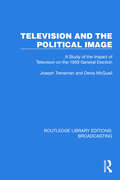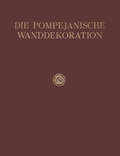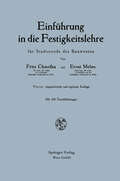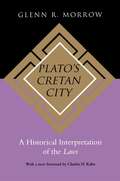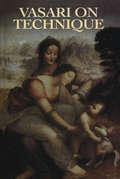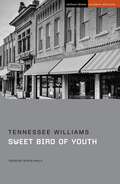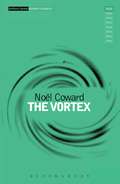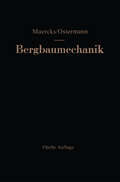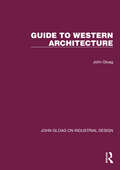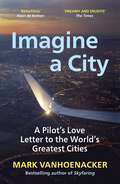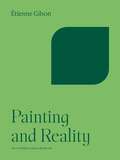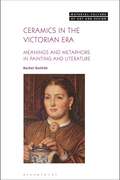- Table View
- List View
Television and the Political Image: A Study of the Impact of Television on the 1959 General Election (Routledge Library Editions: Broadcasting #36)
by Joseph Trenaman Denis McQuailWas the 1959 UK General Election the first television election? Could television be used to create a Party ‘image’? Television and the Political Image (1961) provides answers to both these questions. It surveys two constituencies, interviewing the same cross-section of electors before and after the election campaign, and analyses and compares the campaigns as conducted by television, radio, the Press, and through the work of the local Parties. Various effects of the political barrage are measured and attributed to their sources; such effects include changes in voting intention during the course of the election campaign, changes in attitudes to Parties and their leaders, and changes in what the voter knows of the parties’ policies.
Die Pompejanische Wanddekoration vom Zweiten bis Zum Vierten Stil: Zweiter Band Erster Teil Text
by H. G. BeyenDie fortgesetzte Erscheinung dieses Buches hat sich nach der Publikation des ersten Bandes (1938) aus mehreren Grunden sehr verzogert. Urn sie nicht noch Hinger aufschieben zu miissen, habe ich den zweiten Band nun gar in zwei HaIften geteilt 1). Seit dem Abschluss des Manuskripts des ersten Bandes sind mehrere Arbeiten erschienen, die sich ganz oder teilweise auf unseren Gegenstand iiberhaupt, dagegen nur wenige, die sich ausschliesslich auf den zweiten Stil beziehen (s. die Arbeiten Littles). Die meisten der Arbeiten sind in Band II 1 an den betreffenden Stellen zitiert oder werden in den folgenden Banden zitiert werden. Ausserdem findet man sie zum Teil im Verzeichnis der Abkiirzungen. Die wichtigeren werden S. 3 Anm. 4 erwahnt, einige hebe ich hier sogleich im Text hervor. Das 1944 erschienene Buch Chr. Dawsons hat unsere Kenntnis der "pompejanischen" Wandmalerei und besonders des dritten Stils merklich weitergebracht. Seine Ergebnisse werden zumal im dritten Band ver wertet werden. P. Grimal hat in seinem faszinierenden Werke iiber die romischen Garten viel zu der richtigen Beurteilung der romischen Wandmalerei beigesteuert. K. Schefold hat in seiner nach dem Kriege (1952) erschienenen "Pompejanischen Malerei" als Erster prinzipielle Fragen iiber deren Sinn und Ideengeschichte gestellt und damit die Erforschung des Gegenstandes auf neue Wege gefiihrt. Die spateren kleinen Schriften (1953-1958) setzen seine Gedanken in demselben Sinne fort. Seine "Wande Pompejis" (1957), ein "topographisches Verzeichnis der Bildmotive", fiillen endlich eine schon lange schmerzlich empfundene Liicke aus. A.
Dutch Silver: Wrought Plate of the Central, Northern and Southern Provinces from the Renaissance until the End of the Eighteenth Century
by J.W. FrederiksThis third volume on Dutch Silver does not need a lengthy introduction, since it is a continuation of the second volume, describing and reproducing the wrought plate of the other provinces of the Netherlands, i. e. Zeeland, Utrecht, North-Brabant, Limburg, Gelderland, Overijsel, Friesland and Groningen. The province of Drenthe, until recent years a district with a poor population, has never produced important pieces of silver, but only rather insig nificant "folk art" which need not be included in this book. The general observations contained in the introduction to Volume II apply also to this volume. Here we shall add only certain particular observations regarding the most important and characteristic productions of the various provincial masters. Many of their works are well above the standard normally reached by local celebrities, and some mention of their particular skills and versatility is, therefore, called for. The silver of ZEELAND is, in general, of fine quality and neatly executed. Though this island province, lying between Holland and Belgium, had much easier communications with the Southern Netherlands than with Holland, it is evident that the influence of the latter on the Zeeland silversmiths was predominant. One of the most outstanding pieces of Dutch silver, the eight-pointed dish of 1631 made by the Middelburg silversmith and engraver Johannes Looff (no.
I Paint What I Want to See (Penguin Modern Classics)
by Philip GustonIlluminating reflections on painting and drawing from one of the most revered artists of the twentieth century'Thank God for yellow ochre, cadmium red medium, and permanent green light'How does a painter see the world? Philip Guston, one of the most influential artists of the twentieth century, spoke about art with unparalleled candour and commitment. Touching on work from across his career as well as that of his fellow artists and Renaissance heroes, this selection of his writings, talks and interviews draws together some of his most incisive reflections on iconography and abstraction, metaphysics and mysticism, and, above all, the nature of painting and drawing.'Among the most important, powerful and influential American painters of the last 100 years ... he's an art world hero' Jerry Saltz, New York Magazine'Guston's paintings make us think hard' Aindrea Emelife, Guardian
Plato's Cretan City: A Historical Interpretation of the Laws
by Glenn R. MorrowPlato's Cretan City is a thorough investigation into the roots of Plato's Laws and a compelling explication of his ideas on legislation and social institutions. A dialogue among three travelers, the Laws proposes a detailed plan for administering a new colony on the island of Crete. In examining this dialogue, Glenn Morrow describes the contemporary Greek institutions in Athens, Crete, and Sparta on which Plato based his model city, and explores the philosopher's proposed regulations concerning property, the family, government, and the administration of justice, education, and religion. He approaches the Laws as both a living document of reform and a philosophical inquiry into humankind's highest earthly duty.
Renaissance And Renascences In Western Art
by Erwin PanofskyRenaissance and Renascences in Western Art spans the period from the 10th to the 15th century, including discussion of the Carolingian renaissance and the 12th century proto-renaissance. Erwin Panofsky posits that there were "reanscences" prior to the widely known Renaissance that began in Italy in the 14th century. Whereas earlier renascences can be classified as revivals, the Renaissance was a unique instance that led to a wider cultural transformation.
Vasari on Technique: Being The Introduction To The Three Arts Of Design, Architecture, Sculpture and Painting, Prefixed to the Lives of the Most Excellent Painters, Sculptors and Architects (Dover Art Instruction)
by Giorgio VasariGiorgio Vasari (1511–1571) is well known for his celebrated work on the lives of the Renaissance artists. But not many people know that Vasari was a painter and architect as well as a biographer, and that he wrote one of the most valuable treatises on the technical methods of the painters, architects, and sculptors of his time. This is the first and only English translation of this important technical material (originally published in 1550 as an introduction to Vasari's Lives of the Artists).Vasari, as a practical craftsman, brings to his work as unusual understanding of the processes and materials he writes about, and conveys this knowledge to the reader in a style of the pleasantest and most readable kind. In the section on architecture, he describes the methods used in constructing rustic fountains and grottos; how Michelangelo developed new uses for architectural materials; the architectural uses of enriched plaster; the Renaissance view of Ionic, Doric, Gothic, and other types of architecture; and many similar topics.In the selection on sculpture, the reader will learn about the making of the model, completion of the statue, reliefs, bronze casting, modelled plaster work, sculpture in wood, and other processes. The final section, on painting, discusses aesthetics, perspective, foreshortening, how colors were blended, fresco painting, painting in tempera, oil painting, and much more.Scholars and historians of art have long used this book as the most detailed and valuable sourcebook of its time. But its full, readable discussions, combined with the sense of actuality and historical presence it contains, make it also perhaps the best possible description of the Renaissance artists in the heyday of their achievement.
Baurechtliche Vorschriften des Wohnungsbaues in Österreich: Technische Bauvorschriften (pdf)
by Hugo MischekThe Essays of Erich Neumann, Volume 1: Art and the Creative Unconscious (Works by Erich Neumann #23)
by Erich NeumannFour essays on the psychological aspects of art. A study of Leonardo treats the work of art, and art itself, not as ends in themselves, but rather as instruments of the artist's inner situation. Two other essays discuss the relation of art to its epoch and specifically the relation of modern art to our own time. An essay on Chagall views this artist in the context of the problems explored in the other studies.
The Essays of Erich Neumann, Volume 1: Art and the Creative Unconscious (Works by Erich Neumann #23)
by Erich NeumannFour essays on the psychological aspects of art. A study of Leonardo treats the work of art, and art itself, not as ends in themselves, but rather as instruments of the artist's inner situation. Two other essays discuss the relation of art to its epoch and specifically the relation of modern art to our own time. An essay on Chagall views this artist in the context of the problems explored in the other studies.
Gerrit van Honthorst: A Discussion of his Position in Dutch Art (Utrechtse bijdragen tot de kunstgeschiedenis)
by J. Richard JudsonSweet Bird of Youth (Student Editions)
by Tennessee Williams'Tennessee Williams's mordantly funny and deeply troubled meditation on the desperate dismay of ageing and the iniquities of racial bigotry.' INDEPENDENT 'It's a wonderfully weird play, starting claustrophobic, losing intensity as it introduces the locals… then regrouping for a devastating second half… This unruly, unforgettable play takes its unpredictable course to something that makes you feel afresh our powerlessness against time.' THE TIMES When Chance Wayne left the small town of St. Cloud, he did so with the ambition of being an actor: now, many years later, he returns as a gigolo and the companion of faded movie star Alexandra del Lago. But can Chance convince the town he did actually make it big and win over his childhood sweetheart? Or will the mistakes of his past punish him still? Sweet Bird of Youth is Tennessee Williams's 1959 Broadway hit that explores the social and political climate of 1950s America, at a time when sexual freedom was a critical issue. This edition includes an introduction by Alison Walls that explores the play's production history as well as the dramatic, thematic and academic debates that surround it.
The Vortex (Modern Classics)
by Noël CowardA single-volume edition of one of Coward's masterpieces, published to tie in with major Donmar Warehouse production in December 2002In The Vortex, Coward explores the darker side of the Cocktail Party set. Emotional blackmail, drug abuse and shattered relationships are minutely observed in this disturbing, early piece from a playwright whose sharp eye was more usually turned towards the light.This first ever single-volume edition of this frequently revived Coward play ties in with the major revival directed by Michael Grandage, starring Francesca Annis and Chiwetel Ejiofor and Indira Varma at London's Donmar Warehouse."Here is a piece which is the dernier cri in the theatrical mode, un peu shocking perhaps, but no less popular on that account" James Agate
Bergbaumechanik: Lehrbuch für bergmännische Lehranstalten Handbuch für den praktischen Bergbau
by Josef Maercks Walter OstermannThe Bronze-Iron Age of Indonesia (Verhandelingen van het Koninklijk Instituut voor Taal-, Land- en Volkenkunde #22)
by H.R. HeekerenThe art of metal casting was imported into Indonesia, but its peoples mastered the secrets of metallurgy, and applied these, in ways often original and unique, to create their own distinctive civilisation of the Bronze-Iron Age. In this handbook, which is a sequal to my The Stone Age of Indo nesia, I have endeavoured to assemble a comprehensive picture of the Indonesian Bronze-Iron Age from the results of excavations, innumerable stray finds in museums, and various studies scattered among numerous scientific journals and periodicals (often difficult to obtain). The resulting picture can, of course, be a tentative one only, valid until many more scientific excavations have taken place. I have added a bibliography, as complete as it was possible to assemble. The completion of this summary of the Prehistory of Indonesia has been assisted by a grant-in-aid from the Wenner Gren Foundation "The Viking Fund", New York. I am grateful to Mr. Basoeki and Mr. Soebokastowo for the drawings of Figures 1, 11, 12, 13, 22 and 16, 23, 24, 25 respectively. Figures 2-10 and 15 were drawn by the well-known artist, the late Mas Pirngadie, and are here published for the first time, with the generous permission of the Board of Directors of the "Bataviaasch Genootschap van Kunsten en Wetenschappen", Djakarta. I am deeply grateful to my brother-in-law, Mr. J. H. Reiseger of Kempston, Bedfordshire, for so willingly undertaking the translation of the Dutch text into English.
Dutch Silver: Wrougt Plate of North and South-Holland from the Renaissance Until the End of the Eighteenth Century
by J.W. FrederiksGuide to Western Architecture
by John GloagOriginally published in 1958, A Guide to Western Architecture charts the origins of the system of architectural design that was perfected in Greece, follows its development under the Roman Empire and describes the achievements of the Byzantine architects. Passing through Romanesque to Gothic, the contributions made by Mediaeval builders to structure and design are recorded, and then the impact of the Renaissance on architecture, and its characteristic development in the different European countries. The transplanting of Renaissance ideas to the New World is covered, and finally the origins and nature of the new Western architecture occupy the last section of the book. The Appendix includes a list of the principal architects, and brief notes on their work, from the 5th century B. C. to the end of the Renaissance.
Guide to Western Architecture
by John GloagOriginally published in 1958, A Guide to Western Architecture charts the origins of the system of architectural design that was perfected in Greece, follows its development under the Roman Empire and describes the achievements of the Byzantine architects. Passing through Romanesque to Gothic, the contributions made by Mediaeval builders to structure and design are recorded, and then the impact of the Renaissance on architecture, and its characteristic development in the different European countries. The transplanting of Renaissance ideas to the New World is covered, and finally the origins and nature of the new Western architecture occupy the last section of the book. The Appendix includes a list of the principal architects, and brief notes on their work, from the 5th century B. C. to the end of the Renaissance.
Imagine a City: A Pilot Sees the World
by Mark Vanhoenacker'A journey around both the author's mind and the planet's great cities that leaves us energised, open to new experiences and ready to return more hopefully to our lives' ALAIN DE BOTTON'Enriching... Luminous... A touching survey of human dreams and endeavours' PATRICK GALE___________________A love letter to the cities of the world, from the bestselling pilot-author of Skyfaring.Growing up in his small hometown, Mark Vanhoenacker spun the illuminated globe in his bedroom and dreamt of elsewhere - of distant, real cities, and a perfect metropolis that existed only in his imagination. These places were sources of endless fascination and escape: streets unspooled, towers shone, and anonymous crowds bustled in cities where Mark could be anyone - perhaps even himself.Now, as a commercial airline pilot, Mark has spent nearly two decades crossing the skies of our planet, touching down in the cities he imagined as a child. He experiences these metropolises in short layover visits that repeat month after month and year after year, giving him a unique perspective on the places that form our urban world.Interweaving travelogue with memoir, Mark celebrates the cities he has come to know and love through the lens of the hometown his heart has never left. Exploring the emblematic facets of each city's identity - the sweeping roads of Los Angeles, the old gates of Jeddah, the intricate, dream-inspired plan of Brasília - he shows us with warmth and fresh eyes the extraordinary places that billions of us call home.'I absolutely love the way Mark Vanhoenacker writes about the world; he gives you a whole new way of seeing' JENNY COLGAN'Will transport you around the globe and back again without leaving your seat' MARK OVENDEN, author of Airline Maps and London Underground by Design
Painting and Reality (The A. W. Mellon Lectures in the Fine Arts #4)
by Etienne GilsonA classic study of the art of painting and its relationship to reality In this book, Étienne Gilson puts forward a bold interpretation of the kind of reality depicted in paintings and its relation to the natural order. Drawing on insights from the writings of great painters—from Leonardo, Reynolds, and Constable to Mondrian and Klee—Gilson shows how painting is foreign to the order of language and knowledge. Painting, he argues, seeks to add new beings to nature, not to represent those that already exist. For this reason, we must distinguish it from another art, that of picturing, which seeks to produce images of actual or possible beings. Though pictures play an important part in human life, they do not belong in the art of painting. Through this distinction, Gilson sheds new light on the evolution of modern painting. A magisterial work of scholarship by an acclaimed historian of philosophy, Painting and Reality features paintings from both classical and modern schools, and includes extended selections from the writings of Reynolds, Delacroix, Gris, Gill, and Ozenfant.
Albertus: The Biography of a Typeface (The ABC of Fonts) (The ABC of Fonts)
by Simon GarfieldOne of the most beautiful handcrafted typefaces in the world, Albertus is also one of the most enduring. The face of thousands of book jackets, and the chosen look for David Bowie, Coldplay, Star Wars and London street signs, Albertus is as as warmly enticing on film posters as it is on memorial plaques.The story of the font is one displacement (its designer Berthold Wolpe was a German Jewish refugee who went on to design the masthead for The Times), but also one of permanence, for it has proved a fresh, vibrant and indestructible face for almost a century. In this unique celebration, the designer's children reveal the history of its creation and the erratic brilliance of their father, while the book grapples with one of the fundamental artistic questions: what makes great art not only survive but flourish in each new age and medium?
Art and Analysis: An Essay toward a Theory in Aesthetics
by Edward G. BallardAesthetics, fledgling of the philosophic brood, is the most suspect of that family. It is suspected of all the philosophical sins: vagueness, disorder, dogmatism, emotionalism, reductionism, compartmentalization. Sometimes its youth is thought to be a sufficient excuse for these divagations. Sometimes the very nature of its content, involving the waywardness of genius, the remoteness of feeling from intellect, the surd of inspiration in even the mildest appreciation, are believed to condemn aes thetics irrevocably to the underside of the civilized man's domain. Some philosophers have gloried in this apparently mystical and a-rational quality and have seen in it the very nature of the beautiful; others have come to regard it, rather, as evidence of the unskillfulness of our minds and have turned away from aesthetic problems to the task of sharpening the aesthetician's language and logic. The laughter of the gods is not difficult to discern through the poetry of the more mystical aesthetician or through the prose of the analysts. Meanwhile the manifold complexities and problems of aesthetic experience invite our understanding. For aesthetic experience is a present fact of human life and may, perhaps, be understood by men. Such, at least, will be the present assumption. This is the reason why the title of this book mentions art together with analysis; for if art is intelligible, the work of art and the experience of it may be analyzed into its functional parts.
Ceramics in the Victorian Era: Meanings and Metaphors in Painting and Literature (Material Culture of Art and Design)
by Rachel GotliebThis book broadens the discussion of pottery and china in the Victorian era by situating them in the national, imperial, design reform, and domestic debates between 1840 and 1890. Largely ignored in recent scholarship, Ceramics in the Victorian Era: Meanings and Metaphors in Painting and Literature argues that the signification of a pot, a jug, or a tableware pattern can be more fully discerned in written and painted representations.Across five case studies, the book explores a rhetoric and set of conventions that developed within the representation of ceramics, emerging in the late-18th century, and continuing in the Victorian period. Each case study begins with a textual passage exemplifying the outlined theme and closes with an object analysis to demonstrate how the fusing of text, image, and object are critical to attaining the period eye in order to better understand the metaphorical meanings of ceramics.Essential reading not only for ceramics scholars, but also those of material culture, the book mines the rich and diverse archive of Victorian painting and literature, from the avant-garde to the sentimental, from the well-known to the more obscure, to shed light on the at once complex and simple implications of ceramics' agencies at this time.
